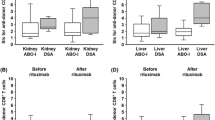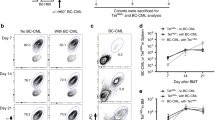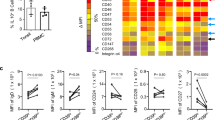Abstract
OX40/OX40 ligand (OX40L) interactions are implicated in costimulation for both CD4+ T and B cells in a bidirectional manner. To determine the role of OX40/OX40L interactions in recipient antidonor responses after multiple allogeneic transfusions, we examined alloreactive cytotoxic T lymphocyte (allo-CTL) activity and alloantibody production in repeatedly alloimmunized OX40L-deficient mice. After the fifth alloimmunization, whereas OX40L-deficient mice showed allo-CTL activity with levels comparable to those of wild-type mice, alloantibody production in OX40L-deficient mice was significantly reduced, accompanied by fewer memory B and CD4+ T cells with reduced function. Furthermore, nu/nu mice that received OX40L-deficient T cells still exhibited impaired alloantibody production with fewer memory CD4+ T and B cells. In contrast, RAG-2-deficient mice that received both wild-type T cells and OX40L-deficient B cells produced scant alloantibodies with fewer memory B cells, but sufficient memory CD4+ T cells. Thus, OX40L on B cells, rather than on T cells, is apparently required for adequate and persistent production of alloantibodies after repeated alloimmunizations.
Similar content being viewed by others
REFERENCES
Kaminski ER, Hows JM, Goldman JM, Batchelor JR: Lymphocytes from multi-transfused patients exhibit cytotoxicity against autologous cells. Br J Haematol 81:23-26, 1992
Grijzenhout MA, Aartd-Riemens MI, Claas FHJ, van Prooijen HC: Prevention of MHC-alloimmunization by UV-B irradiation in a murine model: Effects of UV dose and number of transfused cells. Br J Haematol 87:598-604, 1994
Semple JW, Speck ER, Milev YP, Blanchette V, Freedman J: Indirect allorecognition of platelets by T helper cells during platelet transfusions correlates with anti-MHC antibody and cytotoxic T lymphocyte formation. Blood 86:805-812, 1995
Brand A: Immunological aspects of blood transfusions. Transplant Immunol 10:183-190, 2002
Schiffer CA, Slichter SJ: Platelet transfusion from a single donor. N Engl J Med 307:245-248, 1982
Menitove JE, Aster RA: Transfusion of platelets and plasma products. Clin Haematol 12:239-266, 1983
Schiffer CA: Prevention of alloimmunization against platelets. Blood 77:1-4, 1991
Blajchman MA, Bardossy L, Carmen RA, Goldman M, Heddle NM, Singal DP: An animal model of allogeneic donor platelet refractoriness: The effect of the time of leukodepletion. Blood 79:1371-1375, 1992
Zimmermann R, Wittmann G, Zingsem J, Blasczyk R, Weisbach V, Eckstein R: Antibodies to private and public HLA class I epitopes in platelet recipients. Transfusion 39:772-780, 1999
Benson K, Agosti SJ, Latoni-Benedetti GE, Leparc GF: Acute and delayed hemolytic transfusion reactions secondary to HLA alloimmunization. Transfusion 43:753-757, 2003
Andrew G, Dewailly J, Leberre C, Quarre MC, Bidet ML, Tardivel R, Devers L, Lam Y, Soreau E, Boccacio C, Piard N, Bidet JM, Genetet B, Fauchet R: Prevention of HLA immunization with leukocyte-poor packed red cells and platelet concentrates obtained by filtration. Blood 72:964-969, 1988
Heddle NM: The efficacy of leukodepletion to improve platelet transfusion response: A critical appraisal of clinical studies. Transfus Med Rev 8:15-28, 1994
Kao KJ, Mickel M, Braine HG, Davis K, Enright H, Gernsheimer T, Gillespie MJ, Kickler TS, Lee EJ, McCullough JJ: White cell reduction in platelet concentrates and packed red cells by filtration: A multicenter clinical trial. The Trap Study Group. Transfusion 35:13-19, 1995
Vamvakas EC: Meta-analysis of randomized controlled trials of the efficacy of white cell reduction in preventing HLA-alloimmunization and refractoriness to random-donor platelet transfusions. Transfus Med Rev 12:258-270, 1998
Blundell EL, Pamphilon DH, Fraser ID, Menitove JE, Greenwalt TJ, Snyder EL, Repucci AJ, Hedberg SL, Anderson JK, Buchholz DH, Kagen LR, Aster RH: A prospective, randomized study of the use of platelet concentrates irradiated with ultraviolet-B light in patients with hematologic malignancy. Transfusion 36:296-302, 1996
Kao KJ: Induction of humoral immune tolerance to major histocompatibility complex antigens by transfusions of UVB-irradiated leukocytes. Blood 88:4375-4382, 1996
The Trial to Reduce Alloimmunization to Platelets Study Group: Leukocyte reduction and ultraviolet B irradiation of platelets to prevent alloimmunization and refractoriness to platelet transfusions. N Engl J Med 337:1861-1869, 1997
Kao KL: Effects of leukocyte depletion and UVB irradiation on alloantigenicity of major histocompatibility complex antigens in platelet concentrates: A comparative study. Blood 80:2931-2937, 1992
van de Watering L, Hermans J, Witvliet M, Versteegh M, Brand A: HLA and RBC immunization after filtered and buffy coat-depleted blood transfusion in cardiac surgery: A randomized controlled trial. Transfusion 43:765-771, 2003
Grijzenhout MA, Aarts-Riemens MI, de Gruijl FR, van Weelden H, van Prooijen HC: UVB irradiation of human platelet concentrates does not prevent HLA alloimmunization in recipients. Blood 84:3524-3531, 1994
Janeway CA, Jr, Bottomly K: Signals and signs for lymphocyte responses. Cell 76:275-285, 1994
Jenkins MK: The ups and downs of T cell costimulation. Immunity 1:443-446, 1994
Baum PR, Gayle RB, 3rd, Ramsdell F, Srinivasan S, Sorensen RA, Watson ML, Seldin MF, Baker E, Sutherland GR, Clifford KN: Molecular characterization of murine and human OX40/OX40 ligand systems: Identification of a human OX40 ligand as the HTLV-1-regulated protein gp34. EMBO J 13:3992-4001, 1994
Calderhead DM, Buhlmann JE, van den Eertwegh AJ, Claassen E, Noelle RJ, Fell HP: Cloning of mouse Ox40: A T cell activation marker that may mediate T-B cell interactions. J Immunol 151:5261-5271, 1993
Latza U, Durkop H, Schnittger S, Ringeling J, Eitelbach F, Hummel M, Fonatsch C, Stein H: The human OX40 homolog: cDNA structure, expression and chromosomal assignment of the ACT35 antigen. Eur J Immunol 24:677-683, 1994
Gramaglia I, Weinberg AD, Lemon M, Croft M: Ox-40 ligand: A potent costimulatory molecule for sustaining primary CD4 T cell responses. J Immunol 161:6510-6517, 1998
Gramaglia I, Jember A, Pippig SD, Weinberg AD, Killeen N, Croft M: The OX40 costimulatory receptor determines the development of CD4 memory by regulating primary clonal expansion. J Immunol 165:3043-3050, 2000
Ohshima Y, Yang LP, Uchiyama T, Tanaka Y, Baum P, Sergerie M, Hermann P, Delespesse G: OX40 costimulation enhances interleukin-4 (IL-4) expression at priming and promotes the differentiation of naive human CD4(+) T cells into high IL-4-producing effectors. Blood 92:3338-3345, 1998
Evans DE, Prell RA, Thalhofer CJ, Hurwitz AA, Weinberg AD: Engagement of OX40 enhances antigen-specific CD4 (+) T cell mobilization/memory development and humoral immunity: Comparison of α OX-40 with α CTLA-4. J Immunol 167:6804-6811, 2001
Maxwell JR, Weinberg A, Prell RA, Vella AT: Danger and OX40 receptor signaling synergize to enhance memory T cell survival by inhibiting peripheral deletion. J Immunol 164:107-112, 2000
Rogers PR, Song J, Gramaglia I, Killeen N, Croft M: OX40 promotes Bcl-xL and Bcl-2 expression and is essential for long-term survival of CD4 T cells. Immunity 15:445-455, 2001
Al-Shamkhani A, Birkeland ML, Puklavec M, Brown MH, James W, Barclay AN: OX40 is differentially expressed on activated rat and mouse T cells and is the sole receptor for the OX40 ligand. Eur J Immunol 26:1695-1699, 1996
Al-Shamkhani A, Mallett S, Brown MH, James W, Barclay AN: Affinity and kinetics of the interaction between soluble trimeric OX40 ligand, a member of the tumor necrosis factor superfamily, and its receptor OX40 on activated T cells. J Biol Chem 272:5275-5282, 1997
Stuber E, Neurath M, Calderhead D, Fell HP, Strober W: Cross-linking of OX40 ligand, a member of the TNF/NGF cytokine family, induces proliferation and differentiation in murine splenic B cells. Immunity 2:507-521, 1995
Ohshima Y, Tanaka Y, Tozawa H, Takahashi Y, Maliszewski C, Delespesse G: Expression and function of OX40 ligand on human dendritic cells. J Immunol 159:3838-3848, 1997
Malmstrom V, Shipton D, Singh B, Al-Shamkhani A, Puklavec MJ, Barclay AN, Powrie F: CD134L expression on dendritic cells in the mesenteric lymph nodes drives colitis in T cell-restored SCID mice. J Immunol 166:6972-6981, 2001
Stuber E, Strober W: The T cell-B cell interaction via OX40-OX40L is necessary for the T cell-dependent humoral immune response. J Exp Med 183:979-989, 1996
Matsumura Y, Hori T, Kawamata S, Imura A, Uchiyama T: Intracellular signaling of gp34, the OX40 ligand: Induction of c-jun and c-fos mRNA expression through gp34 upon binding of its receptor, OX40. J Immunol 163:3007-3011, 1999
Morimoto S, Kanno Y, Tanaka Y, Tokano Y, Hashimoto H, Jacquot S, Morimoto C, Schlossman SF, Yagita H, Okumur K, Kobata T: CD134L engagement enhances human B cell Ig production: CD154/CD40, CD70/CD27, and CD134/CD134L interactions coordinately regulate T cell-dependent B cell responses. J Immunol 164:4097-4104, 2000
Parker DC: T cell-dependent B cell activation. Annu Rev Immunol 11:331-360, 1993
van den Eertwegh AJ, Laman JD, Noelle RJ, Boersma WJ, Claassen E: In vivo T-B cell interactions and cytokine-production in the spleen. Semin Immunol 6:327-336, 1994
Gray D, Siepmann K, van Essen D, Poudrier J, Wykes M, Jainandunsing S, Bergthorsdottir S, Dullforce P: B-T lymphocyte interactions in the generation and survival of memory cells. Immunol Rev 150:45-61, 1996
Tanaka H, Demeure CE, Rubio M, Delespesse G, Sarfati M: Human monocyte-derived dendritic cells induce naive T cell differentiation into T helper cell type 2 (Th2) or Th1/Th2 effectors. Role of stimulator/responder ratio. J Exp Med 192:405-412, 2000
Akiba H, Miyahira Y, Atsuta M, Takeda K, Nohara C, Futagawa T, Matsuda H, Aoki T, Yagita H, Okumura K: Critical contribution of OX40 ligand to T helper cell type 2 differentiation in experimental leishmaniasis. J Exp Med 191:375-380, 2000
Jember AG, Zuberi R, Liu FT, Croft M: Development of allergic inflammation in a murine model of asthma is dependent on the costimulatory receptor OX40. J Exp Med 193:387-392, 2001
Flynn S, Toellner KM, Raykundalia C, Goodall M, Lane P: CD4 T cell cytokine differentiation: The B cell activation molecule, OX40 ligand, instructs CD4 T cells to express interleukin 4 and upregulates expression of the chemokine receptor, Blr-1. J Exp Med 188:297-304, 1998
Lane P: Role of OX40 signals in coordinating CD4 T cell selection, migration, and cytokine differentiation in T helper (Th)1 and Th2 cells. J Exp Med 191:201-206, 2000
Murata K, Ishii N, Takano H, Miura S, Ndhlovu LC, Nose M, Noda T, Sugamura K: Impairment of antigen-presenting cell function in mice lacking expression of OX40 ligand. J Exp Med 191:365-374, 2000
Kopf M, Ruedl C, Schmitz N, Gallimore A, Lefrang K, Ecabert B, Odermatt B, Bachmann MF: OX40-deficient mice are defective in Th cell proliferation but are competent in generating B cell and CTL Responses after virus infection. Immunity 11:699-708, 1999
Berke G, Rosen D, Ronen D, Schick B: Immunobiology and molecular characteristics of peritoneal exudates cytotoxic T lymphocytes (PEL), their in vivo IL-2-dependent blasts and IL-2-independent cytolytic hybridomas. In Cytotoxic Cells: Recognition, Effector Function, Generation, and Methods, MV Sitkovsky, PA Henkart (eds). Cambridge, Birkhäuser Boston, 1993, pp 113-127
Coffman RL, Lebman DA, Rothman P: Mechanism and regulation of immunoglobulin isotype switching. Adv Immunol 54:229-270, 1993
Wurster AL, Rodgers VL, White MF, Rothstein TL, Grusby MJ: Interleukin-4-mediated protection of primary B cells from apoptosis through Stat6-dependent up-regulation of Bcl-xL. J Biol Chem 277:27169-27175, 2002
Dancescu M, Rubio-Trujillo M, Biron G, Bron D, Delespesse G, Sarfati M: Interleukin 4 protects chronic lymphocytic leukemic B cells from death by apoptosis and upregulates Bcl-2 expression. J Exp Med 176:1319-1326, 1992
Choe J, Kim HS, Armitage RJ, Choi YS: The functional role of B cell antigen receptor stimulation and IL-4 in the generation of human memory B cells from germinal center B cells. J Immunol 159:3757-3766, 1997
Akiba H, Oshima H, Takeda K, Atsuta M, Nakano H, Nakajima A, Nohara C, Yagita H, Okumura K: CD28-independent costimulation of T cells by OX40 ligand and CD70 on activated B cells. J Immunol 162:7058-7066, 1999
Chen AI, McAdam AJ, Buhlmann JE, Scott S, Lupher ML, Jr, Greenfield EA, Baum PR, Fanslow WC, Calderhead DM, Freeman GJ, Sharpe AH: Ox40-ligand has a critical costimulatory role in dendritic cell: T cell interactions. Immunity 11:689-698, 1999
Diehl S, Rincon M: The two faces of IL-6 on Th1/Th2 differentiation. Mol Immunol 39:531-536, 2002
Trinchieri G: Interleukin-12 and the regulation of innate resistance and adaptive immunity. Nat Rev Immunol 3:133-146, 2003
Linton PJ, Bautista B, Biederman E, Bradley ES, Harbertson J, Kondrack RM, Padrick RC, Bradley LM: Costimulation via OX40L expressed by B cells is sufficient to determine the extent of primary CD4 cell expansion and Th2 cytokine secretion in vivo. J Exp Med 197:875-883, 2003
Bansal-Pakala P, Jember AG, Croft M: Signaling through OX40 (CD134) breaks peripheral T-cell tolerance. Nat Med 7:907-912, 2001
Crotty S, Kersh EN, Cannons J, Schwartzberg PL, Ahmed R: SAP is required for generating long-term humoral immunity. Nature 421:282-287, 2003
Tsukada N, Akiba H, Kobata T, Aizawa Y, Yagita H, Okumura K: Blockade of CD134 (OX40)-CD134L interaction ameliorates lethal acute graft-versus-host disease in a murine model of allogeneic bone marrow transplantation. Blood 95:2434-2439, 2000
Author information
Authors and Affiliations
Corresponding author
Rights and permissions
About this article
Cite this article
Kato, H., Kojima, H., Ishii, N. et al. Essential Role of OX40L on B Cells in Persistent Alloantibody Production Following Repeated Alloimmunizations. J Clin Immunol 24, 237–248 (2004). https://doi.org/10.1023/B:JOCI.0000025445.21894.e5
Issue Date:
DOI: https://doi.org/10.1023/B:JOCI.0000025445.21894.e5




